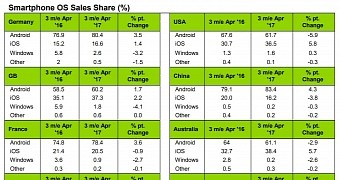This isn’t something that comes out of the blue, but new statistics provided by Kantar for the three-month period ending April 2017 reveal that Windows phones are still collapsing, with sales going down in almost every single big market out there. With one major exception, that is.
Europe, which has long been the top market for Windows phones, makes no exception, and it all starts with Germany where sales have declined 3.2 percent versus the same period of the previous year. This means that only 2.6 percent of the phones sold in the country between February 1 and April 30 were running Windows.
The same thing happened in the United Kingdom as well, where sales dropped 4.1 percent to 1.8 percent, and in France, where the collapse reached 2.7 percent to eventually bring the platform down to 0.9 percent sales share.
Performance in Spain was perfectly in line with the one Windows phones recorded last year, so it remained at 0.6 percent sales share in the country. Overall, the EU5 region brought a decline of 2.8 percent, with Windows phones now at 2.0 percent sales share.
The United States performance
And although everything seems to be pointing to the end of the platform, there’s something that nobody saw coming in the United States.
In Microsoft’s home market, Windows phones actually managed to increase sales, going from 1.3 percent sales share last year to 1.6 percent in 2017. This means they improved sales by 0.3 percent, while rival Android declined no less than 5.9 percent, dropping to 61.7 percent.
Of course, the difference between the two is still huge, and there’s no chance Windows phones get closer to Android, but at least it shows that not everyone is ready to let Microsoft’s mobile platform go. iPhones also experienced a substantial growth in the US, going up 5.8 percent to 36.5 percent sales share.
Other than that, Windows phones also declined 0.3 percent, 2.6 percent, and 0.1 percent in China, Australia, and Japan, respectively, with the platform close to 0 percent share in all three markets.

 14 DAY TRIAL //
14 DAY TRIAL //